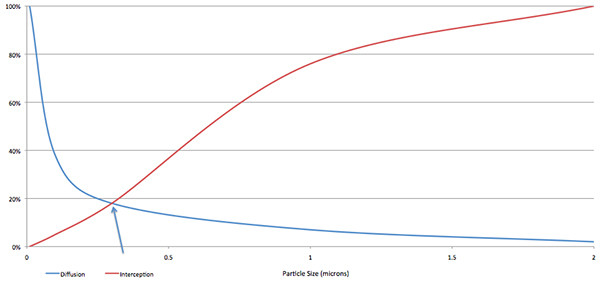What is a HEPA Filter?

The HEPA filter was first developed during World War II by the US government as a way to create an effective gas mask. Little has changed with HEPA filter media since then. They remain the most effective way to remove particulates from the air.
What does the Acronym HEPA Stand for?
By definition, a HEPA filter removes 99.97% or more of airborne particles that are sized 0.3 microns and larger. This is considered the HEPA standard and sometimes called a true HEPA filter.
To give perspective on what this means, it will help to define what a micron is.
A micron is short for micrometer. One micron is one millionth of a meter. This is much smaller than we can see with our naked eye.
Materials in HEPA Filters
HEPA filter media is often made from one of two materials
- Fiberglass – also called glass fiber. We use glass fiber in our Erik Ultra filters and can achieve HEPA performance or better. Fiberglass tends to have the highest filter efficiencies but also the highest pressure drop (air flow resistance).
- Nonwoven Fabric Material – usually polypropylene. This is the type of HEPA air filter media in our EJ and ERIK650A filters. In addition, we charge the filter media so we can achieve better than the HEPA standard and with a low pressure drop. This means better air filtration.
Why Filters are Measured at 0.3 Microns
Allow me a moment to get nerdy and explain why the standard is based on 0.3 microns.
The reason for measuring the HEPA filter efficiency at 0.3 microns is based on the original test equipment that showed this as the point most difficult for a filter to capture airborne particulates.
MPPS
More recent research has revealed the most penetrating particle size (MPPS) to be in the range of 0.12 to 0.17 microns. For the EJ120 the MPPS is at 0.04 microns (40 nanometers).
It’s the weakest point.
It makes sense that performance will increase as particles get bigger but what is not commonly understood is that performance also improves when you move below this point to smaller sized particles.
How Filter Fibers Clean the Air
There are different principles of physics at work that influence particle removal rates and they perform very differently. Taken together, the point where HEPA filters have the lowest efficiency is at the most penetrating particle size.
As seen in the example graph below, diffusion provides higher efficiencies below the MPPS and interception provides higher efficiencies above this point.

Understanding Filter Efficiency
The other aspect of HEPA filters is the 99.97% or more removal rate.
This is the standard set by the Department of Energy. What’s important here is that while these numbers all sound impressive there is a huge difference in performance between 99%, 99.97% and 99.99%+.
A 99.97% performer compared to a 99% will remove much more of the tiniest of particles. This is important size the smallest particle sizes are the most dangerous since they are too small to be captured by your nasal system. They can pass directly to your lungs.
These tiny particles stay suspended in the air the longest and are more likely to be breathed in. This is what can then enter your blood stream and cause health issues.
Filter Ratings
Filter efficiencies are rated differently around the world.
In Europe, the primary standard is EN1822. They use the MPPS (most penetrating particle size) to measure air filter efficiency. Under this standard there are two classes of HEPA filter ratings
- H13 – 99.95% efficiency at MPPS
- H14 – 99.995% efficiency at MPPS
In the US, the most common standard is the MERV Rating (Minimum Efficiency Rating Value).
- MERV 17 – 99.97% efficiency at 0.3 microns and larger
The key difference in these standards is the particle size where the efficiency is measured. In the US, filter efficiency is measured at 0.3 microns whereas in Europe it will likely be in the 0.12 to 0.20 range.
When you go smaller than these particle sizes, filter efficiency usually increases. So, if you see a product marketed as having a certain efficiency at a particle size smaller than this, it is marketing hype. It sounds impressive and takes advantage of most people not understanding how the science works.
The blue “diffusion” line in the chart above shows that performance can increase with smaller sized particles.
HEPA vs ULPA Filters
Environments that require the cleanest air sometimes use an ULPA filter. ULPA stands for Ultra Low Particulate Air. By definition, an ULPA air filter removes 99.999% or more of airborne particles sized 0.1 microns or larger.
So, the ULPA filter removes a higher percentage and it does so at particle sizes smaller than a HEPA filter.
An ULPA filter is what you might see in a cleanroom or a top-level biosafety cabinet. Basically, environments that need to be free of any airborne particles.
This level of air filtration is more than you would need in a home. Although with our ERIK650A air cleaner we offer performance that is better than HEPA filtration and close to ULPA. Our filter media was tested at IBR Laboratories and found to remove 99.996% at the 0.3 micron particle size.
HEPA vs HEPA-Type Filters
True HEPA filters are fairly expensive to manufacture. With a push to provide affordable air purifiers many are sadly marketed as HEPA or true HEPA filters, when in fact they are not.
These filters are probably made with HEPA filter media. However when they are bent to form the small filter (ie less than 2” thick) with little filter media, there can be a significant drop in performance.
If a filter cannot meet the HEPA standard, it technically is a HEPA-type filter. A HEPA type filter is good for removing the big particles like pet hair. If you need to remove smaller particles like fine dust or mold spores then you will be better off with a true HEPA filter.
Are HEPA Air Purifiers Safe?
Yes, air purifiers that use only HEPA filters are safe since they do not emit pollution into your home. These filters collect airborne particles and hold them in the fibers.
However, if the air cleaner uses other technologies like electronic filtering it is possible it can produce ozone. This is a lung irritant and something you will want to avoid. There are standards for ozone emissions and the California Air Resources Board makes sure that air purifiers that are sold into the state of California emit no more to 0.05 ppm of ozone.
Confusion with the HEPA Terms
HEPA is commonly used as a term to mean a high efficiency pleated filter. But there can be huge differences in performance.
As a result, we see this as an issue when you want to compare air purifiers.
A trick that some marketers use is to claim 99.97% effectiveness but in the fine print they say that is for particles 2 microns and larger. Unfortunately, brands do not give you all the information you need to compare how well each can clean the air.
To give you confidence that an air cleaner will give you the clean air you are looking for we wrote How to Choose an Air Purifier. This gives you the key points for what to look for before buying.
HEPA Filter Limitations
HEPA air filters are designed to clean the air of airborne particles. This includes things like pollen, mold spores, fine dust, pet dander, etc.
What is not included in this list are odors and gases. So, if you need to remove cigarette smoke the HEPA filter can catch the tobacco smoke particles but not the smell.
As we show above, HEPA filter fibers work like a sieve to catch small particles. But, gases are much smaller.
To learn how to remove odors please see our guide on activated carbon. This article explains in simple terms what is needed to make your room smell fresher.
Are HEPA Filters Worth It?
As stated earlier, HEPA filters were first invented about 70 years. While this is not a new invention, they are still the best technology for cleaning the air of airborne particulates and they do so safely.
That's why we focus on HEPA as the core filtration technology in our air cleaners. As asthma and allergy sufferers ourselves, we build products that we use and this the best.
Recommendations
What you need depends upon your concerns.
Here are the best air purifiers for allergies and asthma.
For any airborne particle issue like dust, mold spores, pollen, pet dander, etc you will want to use a HEPA air purifier filter.
In most cases you get what you pay for. If you are highly asthmatic or allergic you may want to consider a filter that is more efficient than HEPA.
One way to gauge the quality of the HEPA filter is to find out how much filter media it has in square feet. The more filter media there is the better the HEPA filter generally performs and the longer it will last.
A filter with very little filter media will experience increased air flow resistance much more quickly and as a result will give you get less air flow (air cleaning) more quickly.
